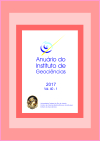BTEX Removal from Aqueous Solution by Modified Multi-Walled Carbon Nanotubes With Ozone
DOI:
https://doi.org/10.11137/2017_1_235_242Keywords:
BTEX, Ozone, Nanotubes, Aqueous SolutionAbstract
Modification of multi-walled carbon nanotube (MWCNT) via ozone was carried out to enhance removal of BTEX from aqueous solution. MWCNT was oxidized by ozone (MWCNT-O3) generator at %80 intensity for 5 min and in 30% NaOCl solution. The images of scanning electron microscopy (SEM) results indicated that the MWCNT-O3 have a lower degree of entanglement with increased porosity compared to the non-modified MWCNT. X-ray diffraction (XRD) test showed that structural crystallization was increased following the modification. After change, the Fourier transform infrared (FTIR) analysis showed that the peaks corresponded to the hydroxyl and carboxylic acid groups in MMWCNT-O3 were more intense than those in non-MMWCNT. The optimum condition for initial BTEX concentration, MWCNT-O3 dose, contact time, and pH was 100 mg/L, 2000 mg/L, 20 min, and 5 respectively. In this optimum condition the efficiency of MWCNT-O3 were increased by %43.5. This study concludes that this method is easy to use and also that ozone is an effective modifier for MWCNT in removal of BTEX compounds from the environment. Keywords: BTEX; Ozone; Nanotubes; Aqueous SolutionDownloads
Published
2018-07-12
Issue
Section
Article
License
This journal is licensed under a Creative Commons — Attribution 4.0 International — CC BY 4.0, which permits use, distribution and reproduction in any medium, provided the original work is properly cited.
















 Except where otherwise noted, content on this site is licensed under a license
Except where otherwise noted, content on this site is licensed under a license 